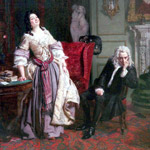Cabinet 18: Blake, Boswell, Gray, and Walpole
Thomas Gray's 'Elegy Written in a Country Churchyard', in William Blake's Water-colour Designs for the Poems of Thomas Gray. London: The Trianon Press for the William Blake Trust, 1972. Special ND 1942 B55 A4 1972
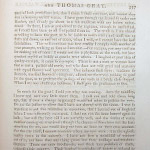 |
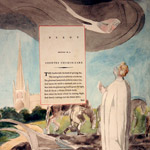 |
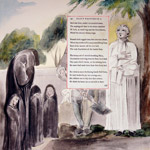 |
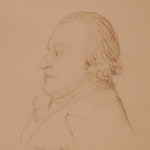 |
Thomas Gray (1716-1771) wrote Elegy written in a Country Churchyard, one of the great poems of the English language. It was first published anonymously in a quarto pamphlet on 15 February 1751. It was an instant success, going through five editions within the year. The year after Gray died, William Blake (1757-1827) was apprenticed to James Basire, engraver to the Society of Antiquaries and the Royal Society. In 1797, after executing 537 designs for Edward Young's Night Thoughts, Blake turned to Gray's Elegy. The project - a commission by John Flaxman as a gift for his wife - resulted in 116 watercolours. Two plus a sketch of Blake are on display.
John Windle, the West Coast antiquarian book dealer claims the Trianon Press facsimile of William Blake's illustrations to Gray's poems is the best book produced in the twentieth century.
The Works of Horatio Walpole, Earl of Orford. Vol. V. London: Printed for G. G. and J. Robinson,… and J. Edwards, 1798. DeB Ec 1798 W
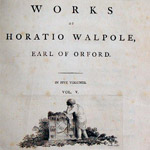 James Boswell called Horace Walpole 'genteel, fastidious, priggish'; the politician and reviewer John Croker believed Walpole 'to have been as bad a man as ever lived'; the Whig wit Joseph Jekyll compared Walpole's Memoirs to 'cold meat on the side table'; and of his article, Lord Macaulay boasted: 'I have laid it on Walpole so unsparingly', revealing Walpole's supposed phenomenal duplicity and hypocrisy: 'mask upon mask'. Despite the often sustained attacks on Walpole, scholars plunder his Memoirs and Letters, essential sources for the history of social life in the eighteenth century. Here he is writing to his friend Thomas Gray.
James Boswell called Horace Walpole 'genteel, fastidious, priggish'; the politician and reviewer John Croker believed Walpole 'to have been as bad a man as ever lived'; the Whig wit Joseph Jekyll compared Walpole's Memoirs to 'cold meat on the side table'; and of his article, Lord Macaulay boasted: 'I have laid it on Walpole so unsparingly', revealing Walpole's supposed phenomenal duplicity and hypocrisy: 'mask upon mask'. Despite the often sustained attacks on Walpole, scholars plunder his Memoirs and Letters, essential sources for the history of social life in the eighteenth century. Here he is writing to his friend Thomas Gray.
James Boswell, The Making of The Life of Johnson. Vol. VI [New York]: Privately Printed [by William Edwin Rudge], 1929. Special PR 3325 A16
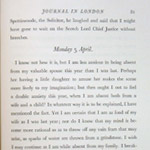 |
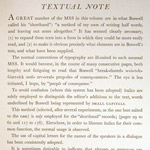 |
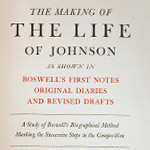 |
'In this view I resolved today to be a true-born Old Englishman. I went into the City to Dolly's Steak-house in Paternoster Row and swallowed my dinner by myself to fulfil the charge of selfishness; I had a large fat beef-steak to fulfil the charge of beef-eating; and I went at five o'clock to the Royal Cockpit in St. James's Park and saw cock-fighting for about seven hours to fulfil the charge of cruelty.' So wrote the Scottish-born James Boswell (1740–1795), lawyer, biographer of Dr Johnson, and, it would seem, master of disguises. Boswell documented his personal, social and professional life and the behaviour of others. In April 1773, just after the birth of his daughter, Boswell visited London. This portion of his Journal - another excellent resource for the social history of the eighteenth century - details his activities, including drinking chocolate with General Pasquale Paoli.

